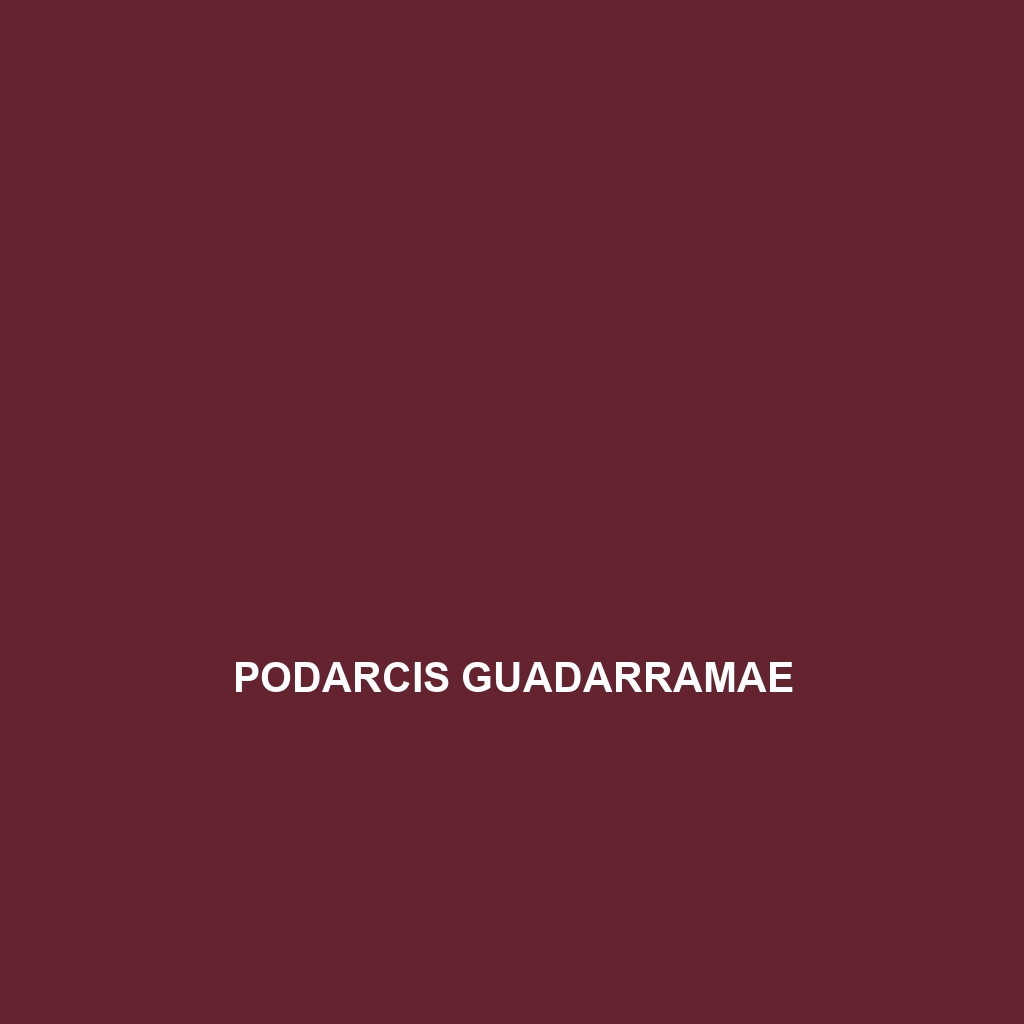Common Name
Podarcis guadarramae
Scientific Name
Podarcis guadarramae
Habitat
The Podarcis guadarramae, commonly known as the Guadarrama lizard, is primarily found in the mountainous regions of central Spain, specifically within the Sierra de Guadarrama. This species prefers habitats that exhibit a range of environmental conditions, thriving in rocky outcrops, grasslands, and scrubland areas characterized by a Mediterranean climate. The climate here typically includes hot, dry summers and mild, wet winters, making it an ideal environment for this lizard. The Guadarrama lizard has been observed basking on warm rocks during daytime, seeking refuge in crevices when temperatures rise, which is prevalent in such temperate forest areas.
Physical Characteristics
The Podarcis guadarramae is a medium-sized lizard, usually ranging from 15 to 25 centimeters in length. Its body is slender with a long tail that can sometimes exceed the body length. The coloration of the Guadarrama lizard can vary significantly; generally, it exhibits a mix of browns, greens, and occasionally vibrant blues or yellows, providing effective camouflage against the natural backdrop of its habitat. Key distinguishing features include a robust head, smooth scales, and a distinctive pattern on the dorsal side that aids in its identification among other similar species within the Podarcis genus.
Behavior
The Podarcis guadarramae is diurnal, spending its days basking in the sun, foraging for food, and engaging in territorial behaviors. These lizards exhibit strong site fidelity, often returning to the same rocks or basking spots daily. Social interactions among males can be quite pronounced, often involving displays of strength and territoriality, including head bobbing and push-ups as part of their mating rituals. Although they are mostly solitary, during the breeding season, they become more social, engaging in courtship displays that can include bright color displays and specific movements aimed at attracting females.
Diet
The dietary habits of Podarcis guadarramae categorize it as an insectivore, primarily feeding on a variety of insects such as ants, beetles, and grasshoppers. These lizards hunt actively, showcasing quick reflexes that allow them to capture prey efficiently. Occasionally, they may consume small plant materials, although their diet is predominantly animal-based. This ability to adapt their diet slightly allows them to thrive in different environmental conditions, ensuring their survival in varying habitats.
Reproduction
The reproductive cycle of the Podarcis guadarramae typically commences in late spring, around May to June, when the temperatures rise. Males engage in elaborate courtship displays to attract females, which involves a series of visual and behavioral signals. After mating, females usually lay a clutch of 3 to 9 eggs in sandy or loose soil, which they incubate for approximately 8 to 10 weeks before hatching occurs. The young lizards are independent from birth, facing the challenges of survival on their own, which is crucial for sustaining their populations.
Conservation Status
Currently, the Podarcis guadarramae is classified as a species of ‘Least Concern’ according to the IUCN Red List. This status reflects its relatively stable population across its range. Nonetheless, this species faces threats from habitat destruction due to urbanization, agricultural expansion, and climate change, which can impact its natural habitat. Ongoing conservation efforts aim to monitor populations and preserve their habitats through protected areas and environmental regulations.
Interesting Facts
One fascinating fact about the Podarcis guadarramae is its remarkable ability to regenerate its tail after losing it to predators, a survival mechanism common in many lizard species. Additionally, this lizard has shown an impressive adaptability to its environment, with studies receiving attention for their findings on its behavioral adjustments to varying climatic conditions. Notably, during the mating season, males can exhibit significant changes in coloration, making them easily distinguishable and appealing to potential mates.
Role in Ecosystem
The Podarcis guadarramae plays a vital role in its ecosystem as both a predator and prey. By controlling insect populations, the Guadarrama lizard contributes to the health of its habitat, ensuring balanced ecological dynamics. They serve as a food source for various birds of prey and larger mammals, thus forming an essential link in the food web. Their presence is indicative of a healthy environment, making them a key species within their native grassland and scrub ecosystems.
